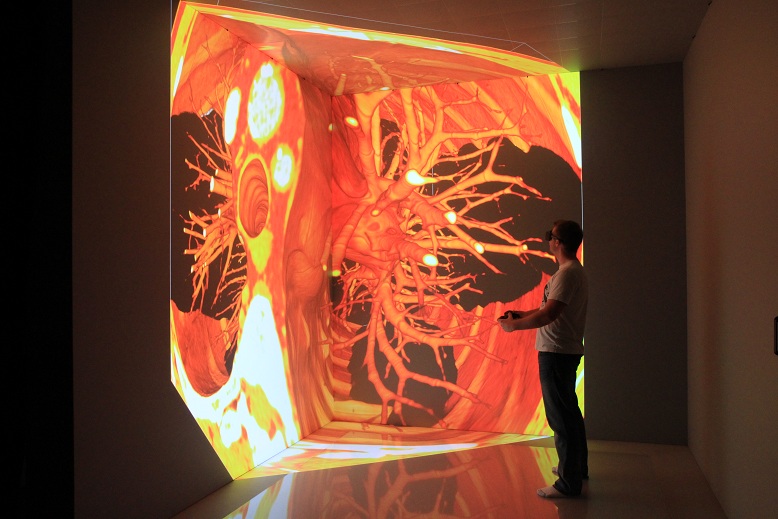Medical Imaging
Graphics technology has extended medical imaging tools to the hands of surgeons and doctors, far beyond the radiology suite. However, a common issue in most medical imaging software is the complexity for non-radiologists to access the patient’s information. Therefore, the Isis project was started to research the area of building medical imaging software for non-radiologists. There are many different sub-projects focusing to improve the quality of medical technology available to surgeons and doctors.
The software package Isis is broken into three key components: CAVE, Desktop and Tablet.
Current Work
Vipre

Vipre is a cross-platform engine for all three platforms (Desktop, Mobile, and Immersive), which allows a seamless transition from one environment to the next depending on the needs of medical professions. The same dataset can be viewed in real-time on the surgeon’s desktop computer, tablet or in an immersive CAVE. Vipre can perform real time volume rendering of digital medical images on iOS devices. This difficult task is made possible using custom developed GPU shaders for orthogonal texture slicing. To ensure smooth interaction novel techniques were required, such as, dynamically modifying render resolutions, an incremental render loop, a shader-based clipping algorithm to support OpenGL ES 2.0, and an internal backface culling algorithm for properly sorting rendered geometry with alpha blending. The application was developed using OpenSceneGraph (OSG) as the primary graphics renderer coupled with iOS Cocoa Touch for user interaction, and DCMTK for DICOM I/O. The application renders volume datasets over 450 slices up to 50-60 frames per second, depending on the specific model of the iOS device. All rendering is done locally on the device hardware, so no Internet connection is required unlike other techniques using HPC clusters to compute the visualization and send an image back to the device over the network.
http://youtu.be/i6rJ1juDzhY
Desktop
The desktop project is a unique software application that is highly customizable and targeted at the general physicians as well as medical specialists. This platform serves as a testing environment for medical imaging functionality such as viewing medical images in two- and three-dimensional representations, clipping, tissue windowing, coloring and interaction. Additional features can be loaded in the form of ‘plug-ins’ such as tumor segmentation, tissue deformation, and surgical planning. This allows the software to be lightweight and easy to use while still giving the user the flexibility of adding the necessary features, this catering to a wide range of user populations. The desktop version is built on Qt, VTK, and DCMTK open-source libraries. The primary function for the desktop version is to study and evaluate the design of medical imaging for the user. Isis has been used to: Evaluate two-dimensional vs. three-dimensional representations for localizing anatomical features.
Previous Work
Tumor Segmentation
Using techniques such as probability generation, fuzzy logic, and colorization; tumors can be automatically segmented from digital medical images (CT/MRI). Current research has produced methods that can segment tumors with 55%-96% accuracy.
- Probabilistic Segmentation – Using a probability generation algorithm based on the Simulated Annealing heuristic optimization algorithm, pixels are segmented based on its spatial and intensity properties.
- Fuzzy Segmentation – Edges around a tumor can sometimes be hard to identify. A fuzzy segmentation algorithm has been developed to overcome this issue, using spatial and intensity properties of the images as well as the information from the previous processed slice.
- Colorization Pre-Processing – Although a CT/MR scan captures a wide range of tissue density, the images are often windowed down and displayed as grayscale images. To fully utilize the entire data range available in the images, a colorization pre-processing method was developed. Based on user interactions, segmentation results can be “tweaked” in real time to produce higher quality segmentation results.
